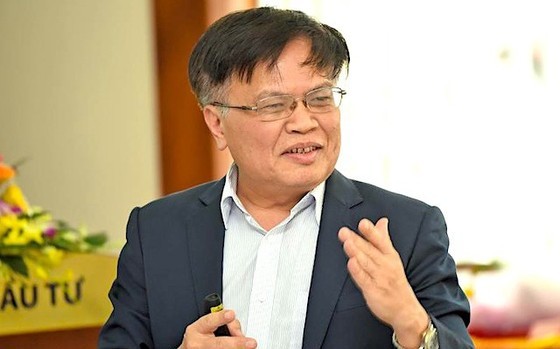 |
Dr. Nguyen Dinh Cung, former director of the Central Institute for Economic Management (CIEM) |
Saigon Investment held a talk with Dr. Nguyen Dinh Cung, former director of the Central Institute for Economic Management (CIEM), to discuss this and related issues.
Journalist: - Sir, HCMC was once seen as the nation’s economic hub. As the one who has vast experience of studying the growth and development of HCMC or many years, how did you feel when the GRDP of HCMC saw a sharp dip in the first quarter of 2023?
Mr. Nguyen Dinh Cung: - It is not surprising to see this as the actual picture of HCMC and the data that accurately reflects the current economic situation. However, it is worrisome when the growth rate of HCMC in the first quarter decreased and was even lower than the overall growth rate of the whole country. Because HCMC is still a major economic center and is still the nation’s economic locomotive, contributing to 22 percent of the overall GDP of the country. The growth of HCMC by one percent is the GDP of the whole country by 0.2 percent, and it also has a spillover effect on many other localities in the region.
The economic decline of HCMC will affect the economic growth of many other provinces in the region. The city is a manufacturing base for exports and a big consumer base that employs workers from other provinces. I am afraid that the provinces that supply raw materials, agricultural products, and food to HCMC will also be affected, and the impact will start to become more visible from the second quarter onwards. Besides, private enterprises are also being affected when the number of enterprises in HCMC accounts for more than 31 percent of the total number of enterprises in the country.
- Sir, in your opinion, are the current bottlenecks and problems of HCMC new or are they due to long-standing neglect?
- The current economic status of HCMC reflects the picture of the whole national economy. The decline of the city was actually predicted at the end of 2022. That was when the decline in the real estate market became apparent and various bottlenecks in infrastructure, connectivity, development planning, local economy, financial institutions, and other vital resources became clear. These bottlenecks have slowed the economy of HCMC in recent years and now the decline is rather sudden and drastic.
Besides, the current administrative apparatus is also overloaded, the entire city is becoming overcrowded and traffic connectivity is becoming more and more congested by the day. During my field trips, I found that the number of civil servants serving in one day in HCMC departments and their branches are equal to the number of civil servants serving in similar departments in other localities for a whole month. In other words, one staff member in the city has to serve the people many times more than the national average, but the salary still remains the same.
These problems do not open up new development space for HCMC, and the long-standing bottlenecks plus new difficulties create a burden for the city. These factors are not just hindering HCMC but the entire Southeast region as well such as the productive Mekong Delta region. It is now vital to look at a new development plan for the southern metropolis and create new transportation systems to connect with other provinces.
The current resources of HCMC are becoming saturated, and their application does not commensurate with the development needs, nor are there enough resources to solve the needs and problems of future development. As the economic locomotive of the country with the largest population, labor concentration, and economic base, the city has public investment per capita lower than the national average. This is a serious bottleneck that needs to be removed soon if HCMC has to be once again transformed to its old glory.
- Sir, in the very near future, the National Assembly will consider and approve the draft amendment for Resolution 54 on a pilot policy for the development of HCMC. If this policy works will HCMC see an economic revival soon?
- The question does arise as to what mechanisms and solutions will be needed and applied to revive the growth of the city in the short term as well as maintain sustainable growth in the medium and long term. HCMC now very clearly needs a dynamic support mechanism to regain its role as an economic locomotive of the country.
I strongly believe that HCMC and the whole country need a new institution as the result of the second wave of reforms, whose motto will be entirely market-based. This is to say that we must build institutions to promote the development of all kinds of markets, so that these markets play a key role in resource mobilization, and allocation, and replace the current outdated administrative resource allocation mechanism.
Only when the market plays a decisive role in everyday administration will it push businesses that use a lot of cheap labor to other more suitable localities, so that resources can be used more efficiently.
The specific mechanism of HCMC was introduced as a pilot program five years back under Resolution 54 but has not produced any really significant results. It is expected that a new resolution with added policies specific to HCMC will be considered and approved by the National Assembly at the next meeting. In my opinion, the new resolution for the city must be a resolution that will create a new superior institution. As of now, it is just an extension of the old mechanism, which is too narrow.
The new resolution must not just be there to remove some of the bottlenecks of the existing institution, but a new, different, and superior institution is now necessary for HCMC. Only then will the development be worthwhile, and HCMCwill once again become the locomotive and strong economic hub for the whole national economy. At the same time, it will be a source of new diverse, and new initiatives to promote economic reforms throughout the country.
- Thank you very much.
























